How to keep a Small Sourdough Starter
I’m going to show you how to keep a small sourdough starter. Why? If you hate throwing away lots of sourdough discard, or you don’t bake as often as you would like, this system will probably work for you.
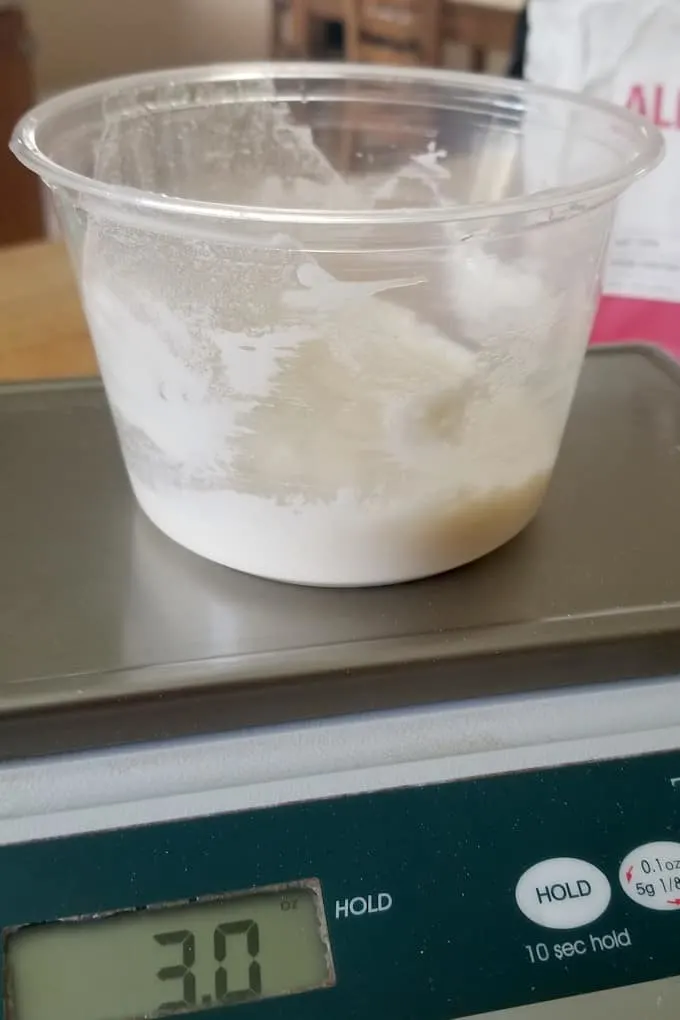
As I said in my original post explaining How to Feed and Maintain a Sourdough Starter, there are a million ways to feed, maintain and use a sourdough starter. I urge you to read through both of my sourdough feeding methods to see which works for you.
If you don’t have one, check out my post to learn How to Make a Sourdough Starter.
Why would you keep a small sourdough starter?
I have always maintained my sourdough starters at 12 oz. Since I write all my sourdough recipes to use 8 oz of starter, that means that each time I use my starter I’m left with 4 oz to continue the feeding cycle.
Keeping a 12 oz starter is convenient if you bake as often as I do. If I’m baking several times per week, I’ve always got enough starter on hand to bake when the mood strikes.
But if you bake less frequently you may find yourself discarding lots of the starter just to maintain it at 12 oz.
It is possible to maintain a smaller starter, which means you have less discard. But the trade off is that you’ll need to allow extra time to grow your starter each time you want to bake.
Once the starter comes out of the refrigerator, it will need a couple of feedings to become active and to have enough volume to bake.
How to feed & maintain a small starter:
- Start with 3 oz of active starter. Store the starter in a small container (pint size) in the refrigerator between baking sessions.
- 36-48 hours before you want to make your dough, take the starter out of the refrigerator.
- Weigh 1 oz of the starter into a quart size container (to accommodate the rising starter). Discard** the other 2 oz of the starter. Feed the 1 oz of starter with 1 oz of all purpose flour and 1 oz of water. You now have 3 oz of starter again.
- Leave the 3 oz starter it at room temperature for 12 – 24 hours. During that time it should double in volume and then begin to settle again. If your starter has been unfed for several weeks and is quite sluggish, you might want to repeat steps 3 and 4 again before proceeding.
- Now you will feed the 3 oz of starter with 3 oz of all purpose flour and 3 oz of water. You will end up with 9 oz of starter.
- Set the starter aside until it has doubled in volume. This usually takes 4-6 hours depending on the temperature of the room and the ingredients.
- Once the starter has doubled in size and begun to recede, remove 1 oz of starter to a pint size container. Feed that with 1 oz each of water and all purpose flour. Use the remaining 8 oz in your recipe.
- Leave the 3 oz of starter at room temperature for 2-3 hours to allow the yeast to begin multiplying, then refrigerate until next time you’re ready to bake or you need to feed it.
Scroll through the step by step process photos to see how to feed a smaller sourdough starter:
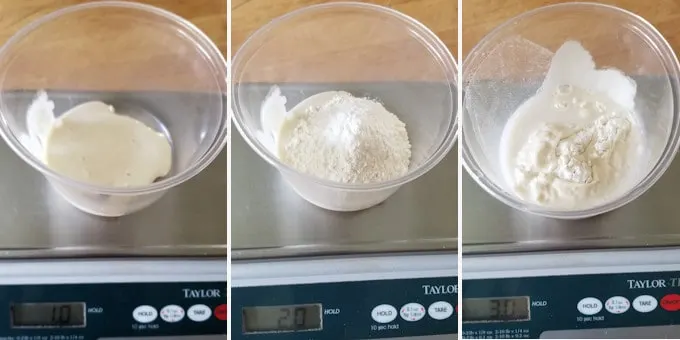
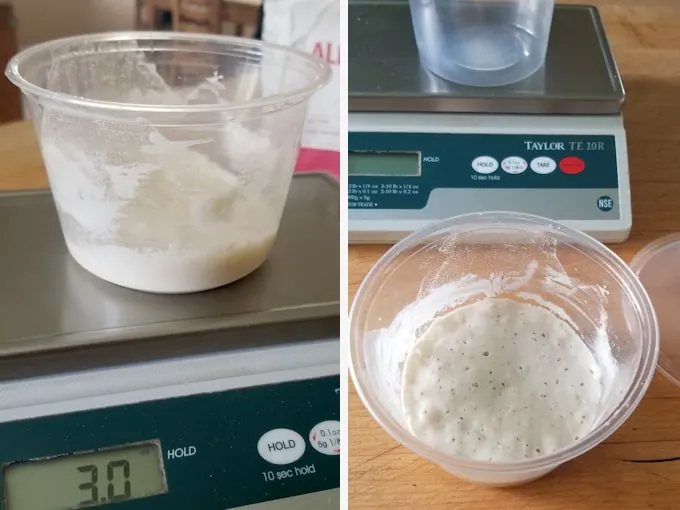
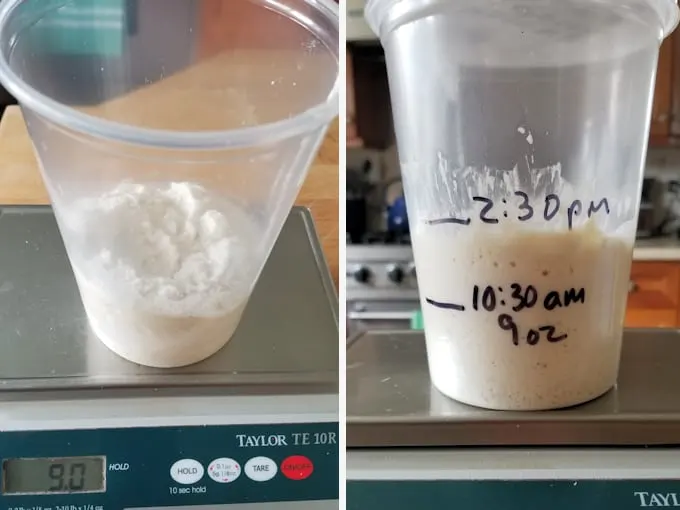
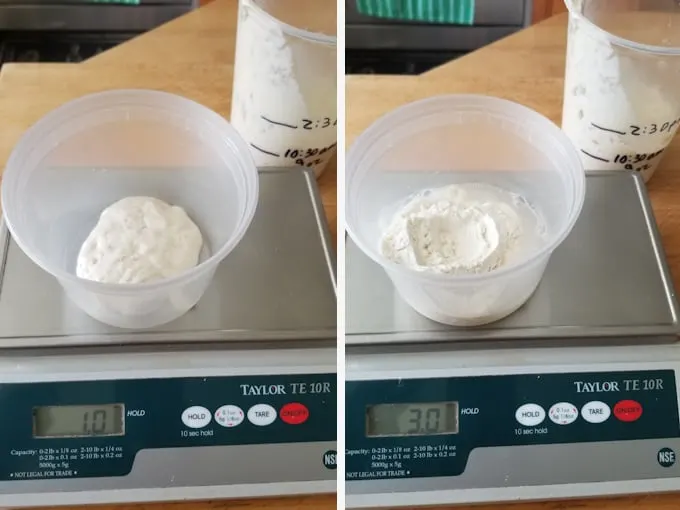
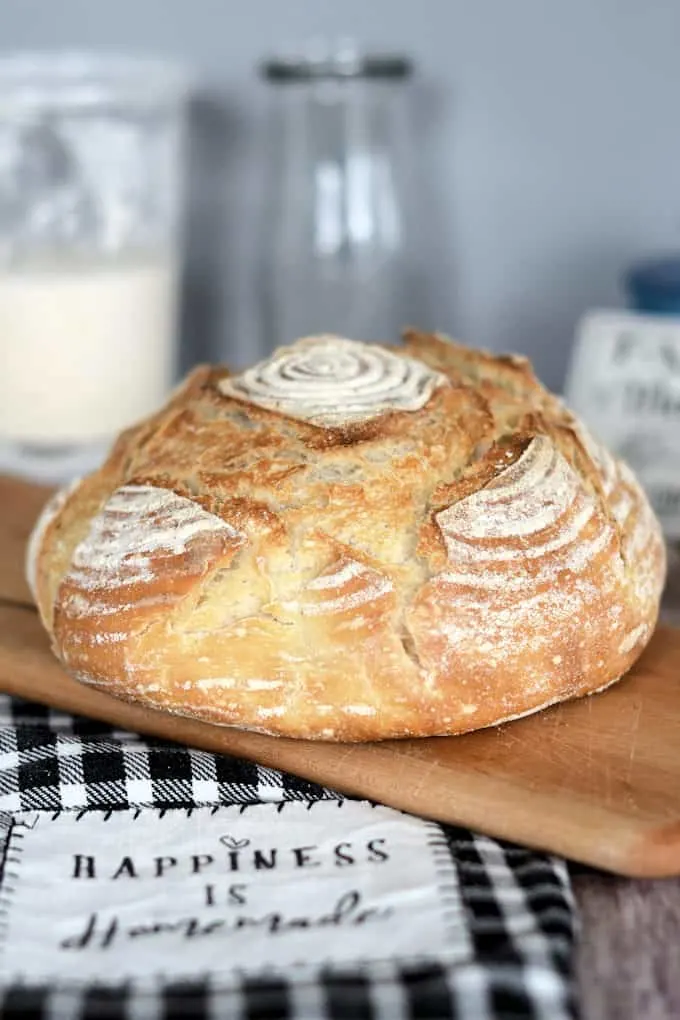
**I know you hate to throw away that sourdough discard. Even though you only need to discard 2 oz, you can save-up that discard in the refrigerator and use it in any number of recipes. Check out these recipes that use sourdough discard.
Finally, if you ever find yourself unable to maintain your starter, you can dry your sourdough starter for long term keeping.
If you find this information helpful, I’d really appreciate a 5-star review.
How to Maintain a Small Sourdough Starter
Equipment
- Wooden spoon or spatula
Materials
- 1 oz unfed sourdough starter
- 1 oz unbleached all purpose flour
- 1 oz water, room temperature
Instructions
- Weigh 1 oz unfed sourdough starter into a clean container. Discard the extra starter or save it in the refrigerator to use in a recipe.
- Add 1 oz unbleached all purpose flour and 1 oz water, room temperature and mix until combined. Set aside at room temperature.
- If you’re not baking, refrigerate 3-4 hours after feeding.
- Feed refrigerated starter weekly if you’re not baking. Each time you feed you will discard 2 oz and use the remaining 1 oz to complete the feeding cycle.
- When you're ready to bake with your starter, you'll need to take it out 1 day before baking and grow the starter with the following steps. Feed the starter as described in steps 1 & 2 (see note). Leave the 3 oz starter at room temperature for 6-12 hours. Feed the 3 oz of starter with 3 oz of all purpose flour and 3 oz of water. You now have 9 oz of starter. Leave it at room temperature for 4-5 hours until it doubles in volume and begins to recede and then it should be ready for baking.
- Use 8 oz in your recipe and reserve the last 1 oz to continue to feeding cycle.

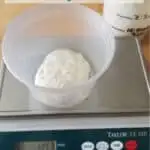
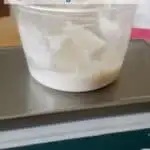
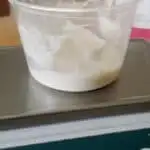
Is there a purpose to the cycle discarding 2 oz of starter? Why couldn’t you just feed the original 3 oz starter, remove 1 oz to save and use the remaining 8 oz starter for your recipe?
There are a lot of ways to maintain a starter. The idea of removing 2 oz then feeding is for times when you are only feeding and don’t have time to bake. You just want to maintain that 3 oz. When my 3 oz is in good shape (not super depleted) and I’m going to bake I do exactly what you describe. I add 3 oz of water and flour. Let it activate. Then remove an oz to feed and maintain 3 oz and use the other 8 oz. But if my 3 oz is not in great shape and I’m not ready to bake I remove 2 oz and feed the 1 oz. Does that make sense?
@Eileen Gray, yes, that makes much more sense. Thanks for the clarification!
If you want to make a smaller loaf and use only say 2 oz, can you use the discard instead of actually discarding it and feed the remaining 1 oz as normal? Or would the discard need to be fed as well?
You can always use the discard instead of discarding it. Here’s a collection of recipes that use discard.
If you keep a smaller starter and want to use the discard in a recipe, would you just keep it in the fridge and add to it as you accumulate more? I am noticing that most discard recipes use a cup of discard and that’s obviously way more than with this method. Would it still be useable if some of it is a lot older, or would you still have to feed it sometimes?
Thanks so much for this guide! It’s really helpful in my first sourdough adventure.
Each time you feed the small starter you discard 2 oz. So you could save those in the fridge until you get 8 oz for a discard recipe (4 feedings). Otherwise, you just go ahead and discard the discard. The small starter is just another option for folks who don’t like all the discard of the regular starter. It really depends on your schedule and how often you bake sourdough recipes.
I have a starter that my daughter gave me a couple of weeks ago. I am keeping it in a mason jar and closing the lid tightly after each feeding. I just eyeball taking out half of it when I feed it and discard what I take out. Do you keep yours in the same container each time you feed it, or transfer it to a new one to measure out the right amount and then discard the rest and wash that container to reuse the next time?
I keep mine in deli containers and will sometimes switch to to a new one so I can clean the container. If you are just eyeballing the amount when you feed it is a little difficult to know the hydration of your starter and that can make a difference when you mix a recipe. You will keep the starter alive with your method, just be aware that your starter may be more or less hydrated that what is called for in a recipe. If you have a kitchen scale I suggest you weigh out the starter for feeding.
@Jennifer Johnson, You say you are keeping the mason jar tightly closed?
Have you had to clean out the kitchen yet? Starters are by their own design, Explosive. It is flour fermenting (putting off gasses) Leave the lid slightly loose. Otherwise it just may explode on you. Not being a smart alec here, I’ve had to clean up that mess Once and only Once. That was enough for me.
I am trying to make a sourdough started and every time I get to day 4 my started is a watery mess. I am thinking my home may not be warm enough. I have tried placing it in the sunlight of a window to make it warmer. Any idea why it is getting so watery. It bubbles and looks great on day 3 then I feed it and it is a thick consistency then is thin and watery the next day. I am using a food scale to be sure my portions are correct.
Thanks,
Keri
Hi Keri. The starter tends to become watery as it needs to be fed. You may just have a very active starter. Try feeding it 2x per day and see how that works. As long as there is activity and it doesn’t become moldy or get red/orange steaks it’s probably alive and kicking.